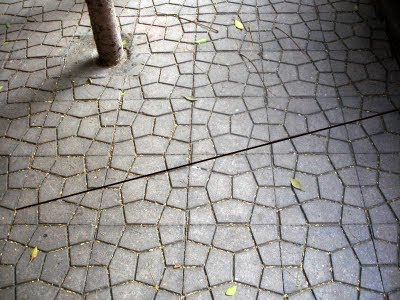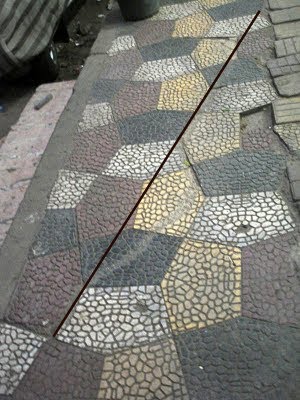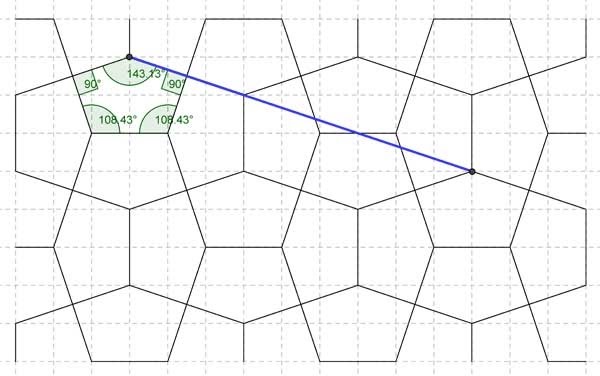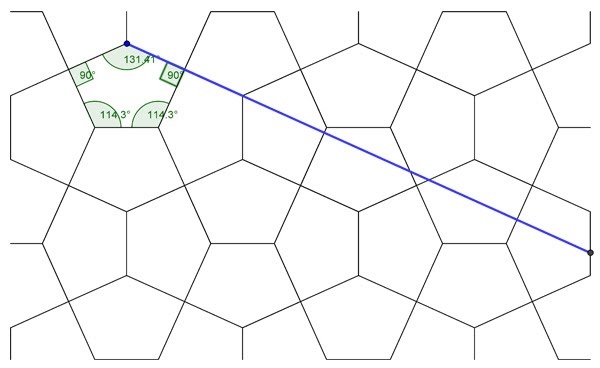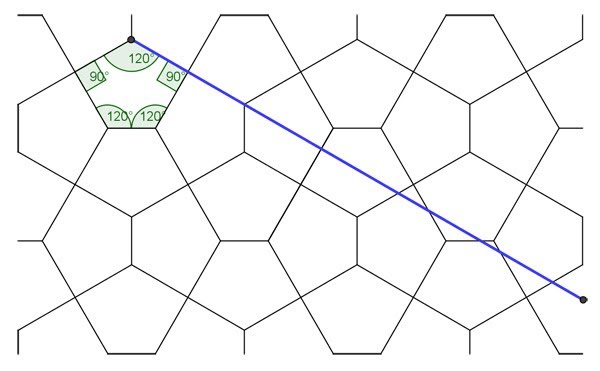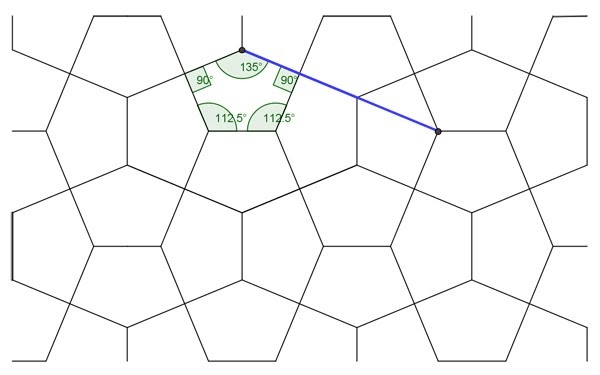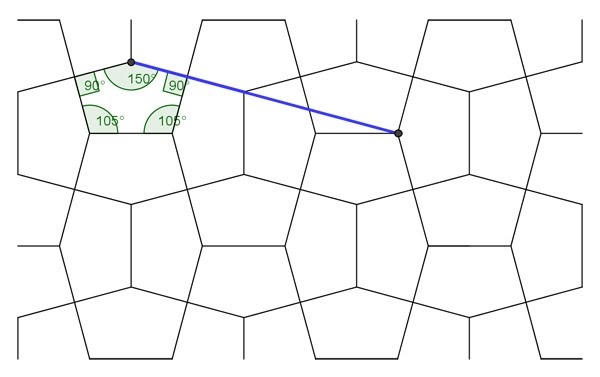or Analysis of the In Situ Tiles as Regards Collinearity and Angles
Introduction Collinearity Premise Collinearity Analysis Figure 1: Collinearity of square format Figure 2: Collinearity of single pentagons Below I show a drawing of the pentagons as according to the condition, along with the angles (Fig. 3). However, at first glance alarmingly, the angles do not match! Macmillan gives 108° 26’ and 143° 8’ , whilst I give 108° 43’ and 143° 13’! Is there some error here? For a long while this remained an open-ended problem. However, I'm pleased to say that this issue has been resolved, as of 11 May 2020! I posted this apparent discrepancy on Twitter, and of which Daniel Piker swiftly provided the answer (he took ten minutes to resolve what I was unable to in ten years! What he pointed out was that we are dealing here with differences between arcminutes (Macmillan) and decimal places (GeoGebra) of which in my ignorance I did not realise the difference! With the insight, when I plugged these into an angle converter, they now match! Thanks, Daniel! I was effectively comparing different measure scales, hence the inconsistency! Therefore, both mine and Macmillan’s pentagon are the same, but simply presented differently. There is thus only one pentagon with such a line of collinearity. https://rechneronline.de/winkel/degrees-minutes-seconds.php 108°26’ converted to decimal = 108.43333. GeoGebra (decimal) gives 108.43 (two decimal places) 143°8' converted to decimal = 143.13333. GeoGebra (decimal) gives 143.13 (two decimal places) An examination of the collinearity, with angles Figure 3: Collinearity condition as according to Macmillan, drawn in GeoGebra by Bailey Further to the above, I also examined other tilings (erroneously) said to be of the Cairo tiling, namely the equilateral pentagon (Fig. 4), the Archimedean Dual 3.3.4.3.4 (Fig. 5) and Cordovan Pentagon (derived from the dissection of a regular octagon) (Fig. 6), as well as another, of my own devising, 'Bailey Pentagon' with foresight, from my studies (Fig. 7). The equilateral pentagon and 3.3.4.3.4 clearly do not possess such collinearity, and so can this easily be dismissed by simple visual inspection. Of course, due to their respective properties, they remain of more interest than other generic Cairo tilings, but they are not of the Cairo tiling. The Cordovan Pentagon and Bailey Pentagon can be seen to possess a degree of collinearity, with the line meeting on a vertices, albeit in different ways, of adjoining pentagons. All are more easily seen than described. However, both these lack the collinearity aesthetics of the Cairo tiling. Figure 4: Equilateral (No Collinearity) Some Examples with Collinearity of Intersection of Vertices Figure 6: Cordovan Pentagon (Collinearity on vertex only) Figure 7: Bailey Pentagon (Collinear on vertex only) Summary As such, with the collinear feature now firmly established, with all the in situ pictures possessing this feature, there can be no doubt whatsoever that the in situ pentagons were designed with collinear aspects in mind. Furthermore, as a corollary of this, as the commonly quoted examples of the equilateral or dual as being the Cairo pentagon do not possess collinearity, they cannot thus be the in situ pentagons! Afterword *Another interesting aspect to Macmillan’s work on this is an indirect reference to possibly the Cairo tiling again in his and E. H. Lockwood’s book Geometric symmetry, of 1978, page 88, of which the following discusses, somewhat as an aside or adjunct to collinearity. The closeness in the dates suggest that this is so. However, although specific as to types of tiling found, his account is frustratingly vague in terms of location, with … the reciprocals of the tessellations 32. 4. 3. 4 and 34. 6 are patterns of congruent pentagons such as often used for street paving in Moslem countries. However, upon searching for such examples, I can find none. Given their relative simplicity, one would have thought that these would be common. The reference to ‘Moslem countries’ is decidedly vague; is he referring to Cairo, which would seem a fair supposition, given that he has clearly visited? Oddly, he makes no direct references here to the in situ pentagons as specifically described in his later pyramids and pavements 1979 paper, although he does refer to the 32. 4. 3. 4 tiling as a ‘special case’ there (amongst others), but apparently just as an abstract sense. However, possible support for this conjecture of such reciprocals existing is that amongst the in situ observations in the 1979 paper he gives, in regards to the Macmillan pentagon: … and this is in fact the proportion often adopted in Cairo…. The operative word here is often, when he could have stated always. This suggests the possibility of variety. But perhaps I am reading too much into this choice of word; was this just a throwaway comment? It would now appear likely, given that there are no sightings of such types, and of the prevailing collinear types. Of note is that the in situ pictures are of same pentagon throughout, albeit in two different formats. What could explain this dichotomy? Likely, the above sentence, of a relatively lightweight nature, was just a relatively throwaway comment, this being in nature of decidedly less exhaustive account than with the 1979 paper. Therefore, I find it highly unlikely that these two reciprocals (duals) are to be found. But that said, why would Macmillan refer to these if he had no evidence? It’s all rather mysterious. References Dunn, James. ‘Tessellations with Pentagons’. The Mathematical Gazette, Vol. 55, No. 394 December 1971, pp. 366-369 Macmillan, Robert H. Mathematical Gazette, 1979. ‘Pyramids and Pavements: some thoughts from Cairo’, pp. 251-255. Schattschneider, Doris. Mathematics Magazine, January. ‘Tiling the Plane with Congruent Pentagons’, pp. 29-44 (p. 30 re Cairo aspect). https://en.wikipedia.org/wiki/Robert_Macmillan Page History 7 October 2011. Page created. 15 May 2020. Clarification and correction as to why I believed the Macmillan and Bailey pentagon were 'different' added as a single paragraph, effectively appended to the page upon the Piker finding. 22 June 2020. In the light of the Piker finding, upon reflection, I decided to drastically rewrite the page, omitting much speculative material regarding Macmillan aspects that had become outdated, especially in regards of what were believed to be two different pentagons, albeit of slight difference. Further, I removed some line diagrams involving the thickness of the grooves drawn in GeoGebra. And added 'Angles' to the title, to better reflect the dual nature of the study. However, although much changed, the page is still broadly recognizable of the first incarnation. |
Cairo Tiling >
